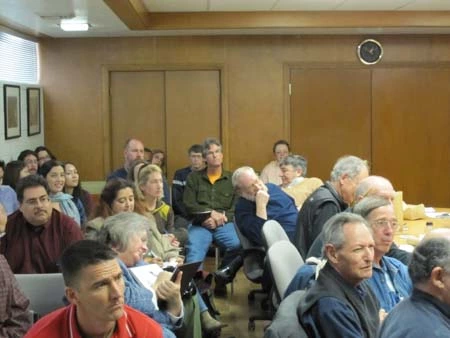Public Policy Review

I was recently in Washington for the annual meeting of water center directors from across the country, and I participated in a panel on outreach. My assignment was to describe the Water Resources Research Center outreach efforts and offer some thoughts about what makes an effective outreach program. As I organized my comments, I thought to Google “outreach” to see what comes up. The website www.thefreedictionary.com provided two definitions, with the first laughably obvious: (1) The act or process of reaching out; and the second with more substance: (2) A systematic attempt to provide services beyond conventional limits, as to particular segments of a community.
High on the list of search results were comments on the Continuing Education portion of the University of Colorado at Boulder web site. Here the term outreach is used “to describe the various ways in which the University extends its expertise for the direct benefit of Colorado communities and other external audiences.” The site goes on to state: “Outreach has traditionally been considered a service activity. However, within a research university, outreach can occur as scholarship that cuts across the University’s teaching, research and creative work, and service missions. Successful outreach is rooted in scholarship and highlights faculty expertise. It draws on knowledge developed through other forms of scholarship and contributes to the knowledge base. Further, federal research agencies such as NSF and NASA increasingly insist that investigators make the outreach component of their research explicit. Outreach activities provide reciprocal benefits to both the community and the academy.”
y and the academy.” Outreach is a fundamental to everything we do at the WRRC, a research and extension unit within the UA College of Agriculture and Life Sciences. Extension and outreach are not synonymous, but they do go hand in hand. As I see it, outreach is a two-way process involving various kinds of expertise and activities. Whether I am in the field making presentations or attending meetings, I am gathering, as well as sharing, information and perspective. In addition, outreach is not separable from research and/or teaching. All can be complementary activities. My work may be helpful to practitioners and policy makers, and what I learn from them can help define research and writing projects. I call on experts from the “real world” to review reports and papers and to provide guest lectures in my graduate course in Arizona water policy. I reach out to them for their expertise. Others reach out to me to gain mine. It is all about sharing knowledge and improving understanding.
Effective outreach takes time, a commodity in short supply for many of us, and requires that we be responsive and accessible. We are responsive when we reply to requests from the media or the public. A response also might be working with a potential project partner to design a study or project to meet its needs as well as WRRC’s programmatic objectives. To be accessible is important as well. WRRC is fortunate to have a location slightly off campus; individuals from the community have easy access to us.
Effective outreach also requires “vehicles,” and the WRRC is fortunate to have several vehicles or outlets. This newsletter is one of our best vehicles. This column provides me an opportunity (with deadline!) to communicate with readers and invite feedback. The Arizona Water Resource newsletter provides broad coverage of water affairs and issues. Reaching out is prime activity of newsletter editor Joe Gelt when preparing the publication. After a five-year hiatus, we recently published an Arroyo newsletter on artificial recharge. Examining the role of artificial recharge in meeting water policy objectives is a focal point of my research. This single-issue newsletter format is one we will increasingly use for outreach.
Our annual conference provides participants an opportunity to learn and discuss. We try, when appropriate, to join with others in developing the conference program. Participating in Water Expo at the Capitol on Feb. 26 provided an opportunity to reach out to our Legislators. Our brown bag seminar series offers additional opportunity for two-way dialogue and for community-university interaction. We focus on topics we believe to be of broad interest to academics from multiple disciplines and members of the water community. We showcase basic research as well as “real-world” happenings.
An oft used outreach vehicle is the Internet, and we at the WRRC endeavor to make effective and extensive use of our web site, now being redesigned, as part of our outreach effort. We post papers and presentations and link to many other water sites. Of course, conference and community presentations are an essential part of effective outreach.
Outreach may be accomplished through vehicles created for a specific purpose. In partnership with the Water Education Foundation, for example, we are writing a Layperson’s Guide to Arizona Water. The Southern Arizona Leadership Council is our partner in developing a fall 2007 Tucson regional water forum. This may take the form of stakeholder meetings focused on a research project. This list of vehicles is long
Outreach requires “outreachers,” preferably people who like to reach out and interact. To effectively reach out requires hard work and careful planning. Our limited financial and personnel resources means we must be strategic in our outreach, not duplicating what others are doing. It means taking the initiative and seizing available opportunities to deliver needed projects or programs.
I will close this column by reaching out to you and asking you to help the WRRC be a more effective outreacher by sharing your thoughts. How can we better reach out? What projects do you want us to consider undertaking? Effective, two-way communication is essential to effective outreach. Call me at 520-792-9591, ext. 21 or email me at smegdal@cals.arizona.edu. I thank you in advance!

